Yugo Murawaki
Investigating Cost-Efficiency of LLM-Generated Training Data for Conversational Semantic Frame Analysis
Oct 09, 2024



Abstract:Recent studies have demonstrated that few-shot learning allows LLMs to generate training data for supervised models at a low cost. However, the quality of LLM-generated data may not entirely match that of human-labeled data. This raises a crucial question: how should one balance the trade-off between the higher quality but more expensive human data and the lower quality yet substantially cheaper LLM-generated data? In this paper, we synthesized training data for conversational semantic frame analysis using GPT-4 and examined how to allocate budgets optimally to achieve the best performance. Our experiments, conducted across various budget levels, reveal that optimal cost-efficiency is achieved by combining both human and LLM-generated data across a wide range of budget levels. Notably, as the budget decreases, a higher proportion of LLM-generated data becomes more preferable.
Beyond English-Centric LLMs: What Language Do Multilingual Language Models Think in?
Aug 20, 2024

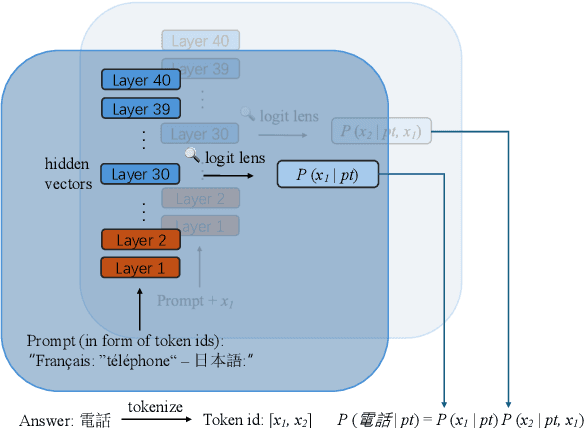
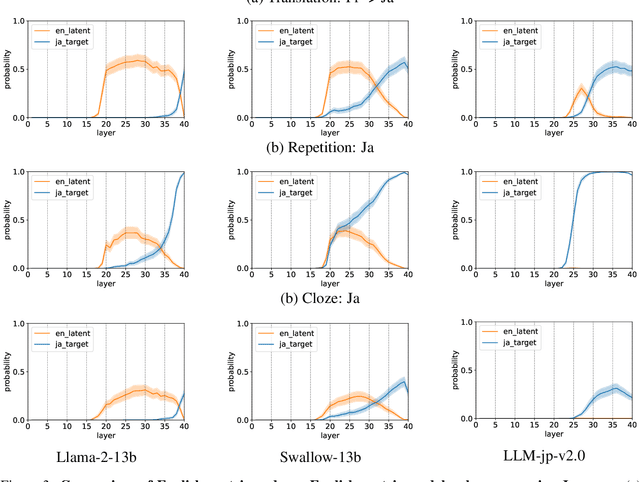
Abstract:In this study, we investigate whether non-English-centric LLMs, despite their strong performance, `think' in their respective dominant language: more precisely, `think' refers to how the representations of intermediate layers, when un-embedded into the vocabulary space, exhibit higher probabilities for certain dominant languages during generation. We term such languages as internal $\textbf{latent languages}$. We examine the latent language of three typical categories of models for Japanese processing: Llama2, an English-centric model; Swallow, an English-centric model with continued pre-training in Japanese; and LLM-jp, a model pre-trained on balanced English and Japanese corpora. Our empirical findings reveal that, unlike Llama2 which relies exclusively on English as the internal latent language, Japanese-specific Swallow and LLM-jp employ both Japanese and English, exhibiting dual internal latent languages. For any given target language, the model preferentially activates the latent language most closely related to it. In addition, we explore how intermediate layers respond to questions involving cultural conflicts between latent internal and target output languages. We further explore how the language identity shifts across layers while keeping consistent semantic meaning reflected in the intermediate layer representations. This study deepens the understanding of non-English-centric large language models, highlighting the intricate dynamics of language representation within their intermediate layers.
LLM-jp: A Cross-organizational Project for the Research and Development of Fully Open Japanese LLMs
Jul 04, 2024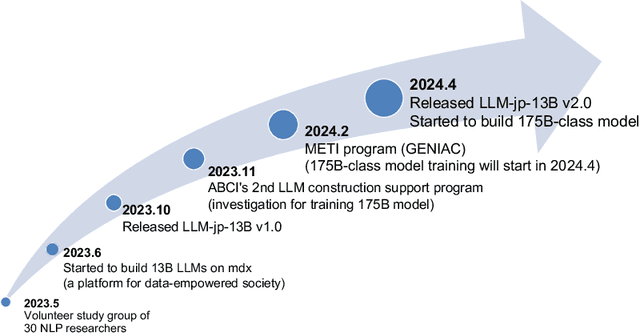
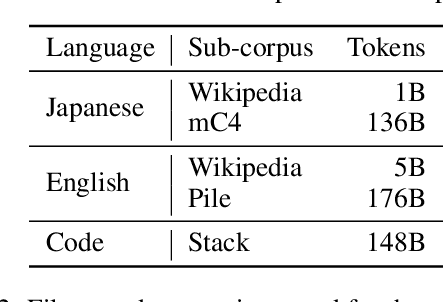


Abstract:This paper introduces LLM-jp, a cross-organizational project for the research and development of Japanese large language models (LLMs). LLM-jp aims to develop open-source and strong Japanese LLMs, and as of this writing, more than 1,500 participants from academia and industry are working together for this purpose. This paper presents the background of the establishment of LLM-jp, summaries of its activities, and technical reports on the LLMs developed by LLM-jp. For the latest activities, visit https://llm-jp.nii.ac.jp/en/.
Principal Component Analysis as a Sanity Check for Bayesian Phylolinguistic Reconstruction
Feb 29, 2024



Abstract:Bayesian approaches to reconstructing the evolutionary history of languages rely on the tree model, which assumes that these languages descended from a common ancestor and underwent modifications over time. However, this assumption can be violated to different extents due to contact and other factors. Understanding the degree to which this assumption is violated is crucial for validating the accuracy of phylolinguistic inference. In this paper, we propose a simple sanity check: projecting a reconstructed tree onto a space generated by principal component analysis. By using both synthetic and real data, we demonstrate that our method effectively visualizes anomalies, particularly in the form of jogging.
Addressing Segmentation Ambiguity in Neural Linguistic Steganography
Nov 12, 2022



Abstract:Previous studies on neural linguistic steganography, except Ueoka et al. (2021), overlook the fact that the sender must detokenize cover texts to avoid arousing the eavesdropper's suspicion. In this paper, we demonstrate that segmentation ambiguity indeed causes occasional decoding failures at the receiver's side. With the near-ubiquity of subwords, this problem now affects any language. We propose simple tricks to overcome this problem, which are even applicable to languages without explicit word boundaries.
Frustratingly Easy Edit-based Linguistic Steganography with a Masked Language Model
Apr 20, 2021



Abstract:With advances in neural language models, the focus of linguistic steganography has shifted from edit-based approaches to generation-based ones. While the latter's payload capacity is impressive, generating genuine-looking texts remains challenging. In this paper, we revisit edit-based linguistic steganography, with the idea that a masked language model offers an off-the-shelf solution. The proposed method eliminates painstaking rule construction and has a high payload capacity for an edit-based model. It is also shown to be more secure against automatic detection than a generation-based method while offering better control of the security/payload capacity trade-off.
A System for Worldwide COVID-19 Information Aggregation
Jul 28, 2020


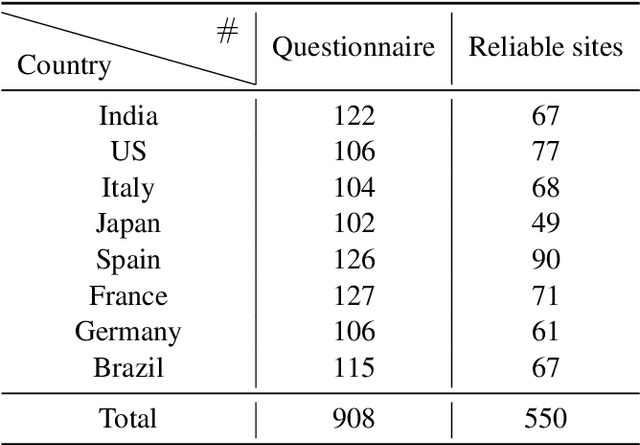
Abstract:The global pandemic of COVID-19 has made the public pay close attention to related news, covering various domains, such as sanitation, treatment, and effects on education. Meanwhile, the COVID-19 condition is very different among the countries (e.g., policies and development of the epidemic), and thus citizens would be interested in news in foreign countries. We build a system for worldwide COVID-19 information aggregation (http://lotus.kuee.kyoto-u.ac.jp/NLPforCOVID-19 ) containing reliable articles from 10 regions in 7 languages sorted by topics for Japanese citizens. Our reliable COVID-19 related website dataset collected through crowdsourcing ensures the quality of the articles. A neural machine translation module translates articles in other languages into Japanese. A BERT-based topic-classifier trained on an article-topic pair dataset helps users find their interested information efficiently by putting articles into different categories.
Minimally Supervised Learning of Affective Events Using Discourse Relations
Sep 02, 2019



Abstract:Recognizing affective events that trigger positive or negative sentiment has a wide range of natural language processing applications but remains a challenging problem mainly because the polarity of an event is not necessarily predictable from its constituent words. In this paper, we propose to propagate affective polarity using discourse relations. Our method is simple and only requires a very small seed lexicon and a large raw corpus. Our experiments using Japanese data show that our method learns affective events effectively without manually labeled data. It also improves supervised learning results when labeled data are small.
On the Definition of Japanese Word
Jun 24, 2019
Abstract:The annotation guidelines for Universal Dependencies (UD) stipulate that the basic units of dependency annotation are syntactic words, but it is not clear what are syntactic words in Japanese. Departing from the long tradition of using phrasal units called bunsetsu for dependency parsing, the current UD Japanese treebanks adopt the Short Unit Words. However, we argue that they are not syntactic word as specified by the annotation guidelines. Although we find non-mainstream attempts to linguistically define Japanese words, such definitions have never been applied to corpus annotation. We discuss the costs and benefits of adopting the rather unfamiliar criteria.
 Add to Chrome
Add to Chrome Add to Firefox
Add to Firefox Add to Edge
Add to Edge